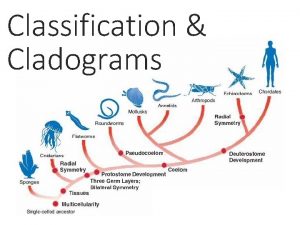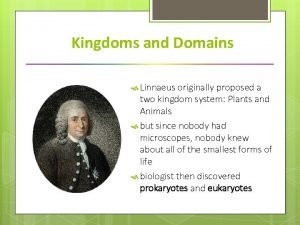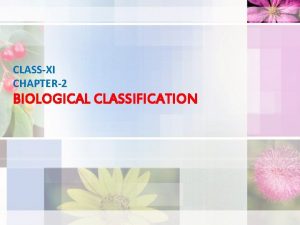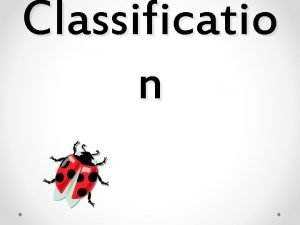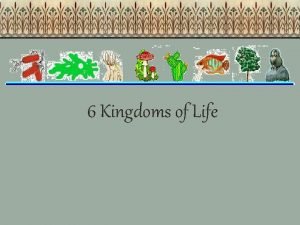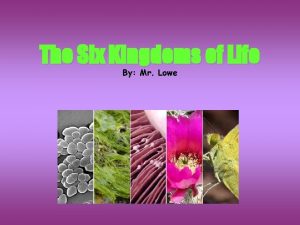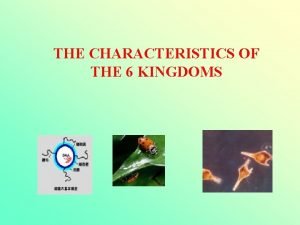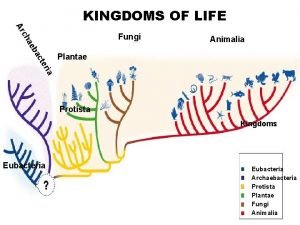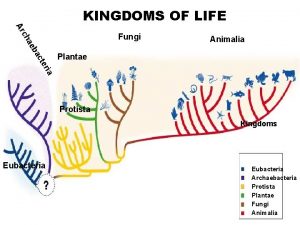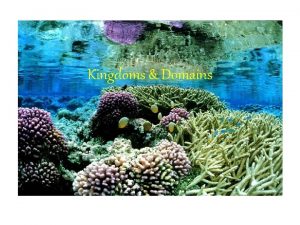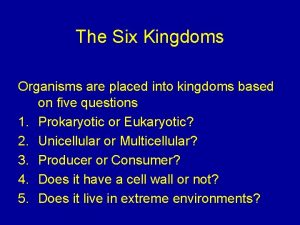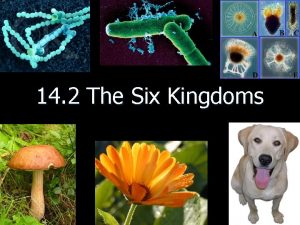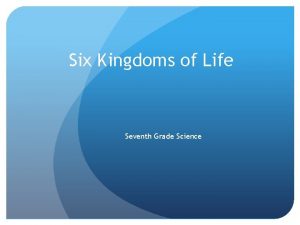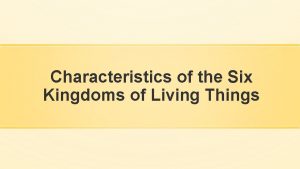Characteristics of the Six Kingdoms How do we














- Slides: 14

Characteristics of the Six Kingdoms How do we know where each organism belongs?

Domain: Archaea Kingdom: Archaebacteria Some are heterotrophic, some are autotrophic Unicellular Prokaryote Some (They do NOT have a nucleus) can move, some cannot move Reproduce Types: Loving by Binary Fission Salt-Loving, Heat-Loving, and Methane-

The Grand Prismatic Spring in Yellowstone National Park The Dead Sea in Egypt

Domain: Bacteria Kingdom: Eubacteria Some are heterotrophic, some are autotrophic Unicellular Prokaryote Some can move, some cannot Reproduce by Binary Fission Some help return nutrients to soil, aid in digestion, and help clean up oil spills

Escherichia coli (E-coli) Streptococcus pyogenes 3 shapes/types of bacteria Anthrax Bacteria found on the Tongue

Domain: Eukarya Kingdom: Protista Plant-like are Autotrophic while Animal-like are Heterotrophic Both; some are Unicellular some are Multicellular Eukaryote Some (They have a nucleus) can move some cannot Reproduce by sexual and/or asexual reproduction

Protista Volvox Euglena Slime Mold Algae Paramecium Amoeba

Domain: Eukarya Kingdom: Fungi Heterotrophic Both; – they are DECOMPOSERS some are unicellular, some are multicellular Eukaryote CANNOT move Reproduce by sexual and/or asexual reproduction

Fungi Mushroom Athlete’s Foot Yeast Foot Fungus Ringworm Bread Mold – Microscopic View Bread Mold

Domain: Eukarya Kingdom: Plantae Autotrophic – through PHOTOSYNTHESIS Multicellular Eukaryote CANNOT MOVE Reproduce by sexual and/or asexual reproduction

Plantae Apple Tree Corn Cactus Giant Sequoia Dandelion Magnolia Tree

Domain: Eukarya Kingdom: Animalia Heterotrophic Multicellular Eukaryote Moves Reproduces by sexual and/or asexual reproduction

Animalia Human Worms Hydra Daphnia Dogs Butterfly Shark

Which Kingdom? Archaebacteria ? ? ? Eubacteria Protista Eubacteria Animalia Fungi Protista Fungi
 Common characteristics of the six kingdoms of life
Common characteristics of the six kingdoms of life Common characteristics of the six kingdoms of life
Common characteristics of the six kingdoms of life Characteristics of the six kingdoms
Characteristics of the six kingdoms Dichotomous key kingdoms
Dichotomous key kingdoms The six kingdoms
The six kingdoms Six kingdoms worksheet
Six kingdoms worksheet What is classificatio
What is classificatio 3 domains and 6 kingdoms chart
3 domains and 6 kingdoms chart Six kingdoms of living things
Six kingdoms of living things What are the three domains and six kingdoms?
What are the three domains and six kingdoms? What are the six kingdoms of life?
What are the six kingdoms of life? The 6 animal kingdoms
The 6 animal kingdoms Protista characteristics chart
Protista characteristics chart Classify each polygon
Classify each polygon Hình ảnh bộ gõ cơ thể búng tay
Hình ảnh bộ gõ cơ thể búng tay
